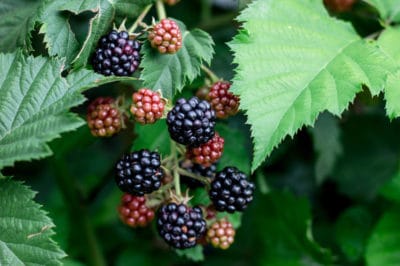U.S Blackberry Production
With more than 6 thousand acres regularly yielding annual harvests in excess of 40 million pounds, Oregon leads the United States in blackberry production. California and Washington State hold the second and third spots.
Thanks to the introduction of several cultivars from the University of Arkansas, several Southeastern states also have expanding commercial blackberry-growing operations.
Expert gardeners tip: Less than 8 percent of Oregon’s blackberries are grown for the fresh fruit market. There’s a 3 in 4 chance that the fresh berries you buy at your grocery store came from Mexico.
Blackberry Climate Requirements:
Even though a few blackberry cultivars thrive in the balmy winters of USDA hardiness zone 9, it’s only because they require no more than 300 chill units each year. What are chill units?
Blackberries bushes respond to fall’s dropping temperatures by going dormant. It’s their way of protecting their developing buds against sub-freezing weather. They’ll remain in dormancy until they spend enough hours at temperatures between 33° and 45°F (0.55° and 7.2°C).
Blackberries that don’t get enough chill units in winter won’t leaf out and bloom properly the following spring. But chill unit requirements widely among different blackberries, including these popular cultivars:
- ‘Kiowa’: 200-300 chill units
- ‘Natchez,’ ‘Prime-Ark 45’: 300 chill units
- ‘Prime-Jim:’ 300-400 chill units
- ‘Osage’: 350-450 chill units
- ‘Ouachita,’ ‘Arapaho’: 400-500 chill units
- ‘Apache,’ ‘Navaho’: 800-900 chill units
Whether your climate includes short and balmy or long and frigid winters, it shouldn’t be difficult to find a cultivar you can grow.
Blackberries and Rain
The ideal blackberry growing climate would provide 1 inch of water each week throughout the growing season. So a big part of caring for your bushes comes from providing adequate water when Mother Nature falls short.
The most effective way to water the plants during dry spells is via drip irrigation. Start with 2 to 3 gallons (7.57 to 11.36 liters) daily per bush and adjust the amount depending on how well they handle it, but never water enough to saturate the roots.
